Apostle Junia in Philadelphia, Sardis, and Smyrna
- Elaine R Kelly

- Jul 24
- 11 min read
Updated: Nov 22
My upcoming historical fiction imagines the backstory of Junia, a woman in the Bible who is called an apostle. This series of articles describes some of the cities and people she visits in the fictional first mission journey Junia takes in my novel, Finding Her Voice from Broken to Bold: A Novel of Early Female Apostles.
Articles about Apostle Junia
Apostle Junia: Who Is She? Paul's description of Junia in Romans 16:7
Apostle Junia: Making Disciples with a hammer or a carrot?
Apostle Junia in Syrian Antioch: meeting Andronicus and beginning her ministry
Apostle Junia in Colossae, Laodicea, Hierapolis.
Apostle Junia in Philadelphia, Sardis, and Smyrna.
Junia's Fictional First Missionary Journey:
Following the cities Junia may have visited on these major trade routes, I imagine her first mission journey goes from Syrian Antioch to Perga, Colossae, Laodicea, Hierapolis, Philadelphia, Sardis, and Smyrna.

Four of these are cities with churches mentioned in the book of Revelation, which names seven churches:
Laodicea (Revelation 3:14-22): called lukewarm; worldly wealthy, spiritually poor
Philadelphia, now Alaşehir (Revelation 1:11 and 3:7-13): steadfast, faithful, enduring
Sardis (Revelation 3:1-6): spiritually dead, while having a reputation for being alive/a city that never sleeps
Smyrna (Revelation 2:8–11): has a great harbour; prophesied to suffer persecution
Three not on Junia's fictional journey:
Thyatria (Revelation 2:18-29): known for its dyer, tanner, and bronze trade guilds. Lydia is from Thyatira (Acts 16:14).
Pergamon (Revelation 2:12-17): told to repent from allowing false teachings
Ephesus (Revelation 2:1-7): faithful.
Philadelphia
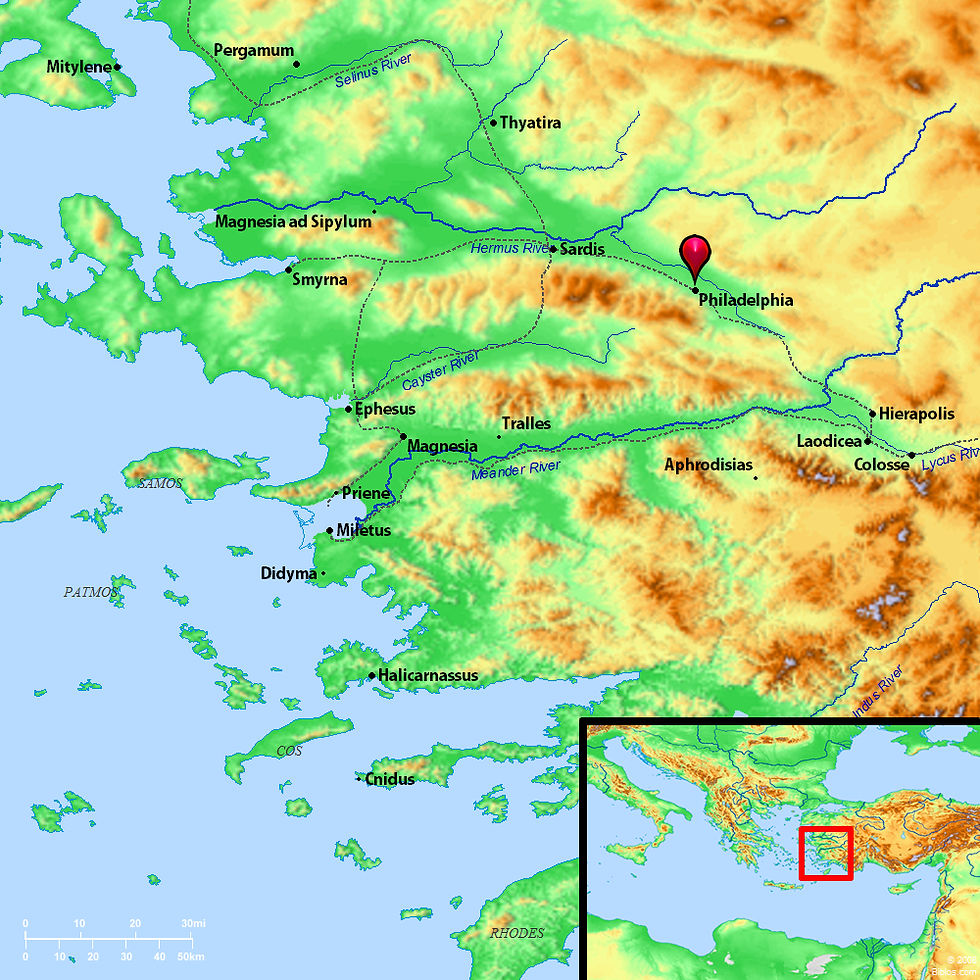
The Place
Philadelphia was located in the Catacecaumene, an earthquake-prone region. The name Philadelphia comes from two Greek words: filio meaning love, and adelphos, meaning brotherly. King Attalus of Pergamon named it out of his great love for his brother Eumenes II [1]. Philadelphia suffered a great earthquake in AD 17, but Emperor Tiberius relieved them of taxes, and they were able to rebuild.
The land area around Philadelphia was rich in agriculture, especially grapes and wine.
Philadelphia was situated between volcanic cliffs on one side and fertile fields of red soil vineyards on the other [2]. Its excellent wine was celebrated by the Roman poet, Virgil. Philadelphia was a wealthy trade centre with grand temples and public buildings.
Religion in Philadelphia
They worshipped the god Dionysus, the Greek god of wine and fertility. He is a dualistic figure, enjoying both wildness and civilization. Philadelphia also had Jewish residents and people who were mystics or worshipped Roman or Greek gods.
Philadelphia in Revelation
Philadelphia and Smyrna are the only two of the seven churches mentioned in Revelation that are commended. Philadelphia is credited as faithful.
“And to the angel of the church in Philadelphia write:
These are the words of the Holy One, the True One, who has the key of David, who opens and no one will shut, who shuts and no one opens [Jesus Christ]:
“I know your works. Look, I have set before you an open door that no one is able to shut. I know that you have but little power, yet you have kept my word and have not denied my name. I will make those of the synagogue of Satan who say that they are Jews and are not but are lying—I will make them come and bow down before your feet, and they will learn that I have loved you. Because you have kept my word of endurance, I will keep you from the hour of trial that is coming on the whole world to test the inhabitants of the earth. I am coming soon; hold fast to what you have, so that no one takes away your crown. If you conquer, I will make you a pillar in the temple of my God; you will never go out of it. I will write on you the name of my God and the name of the city of my God, the new Jerusalem that comes down from my God out of heaven, and my own new name. Let anyone who has an ear listen to what the Spirit is saying to the churches (Revelation 3:7-13 NRSVUE).
Jesus says he has opened a door that no one can shut, and while this may refer to God giving Eliakim the key to the house of David (Isaiah 22:20-22), I believe that when Jesus came, Jesus held the keys. I think John's Revelation refers to Jesus when he says, "I am the door of the sheep. All who ever came before Me are thieves and robbers, but the sheep did not hear them. I am the door. If anyone enters by Me, he will be saved, and will go in and out and find pasture (John 10:7-9 NKJV). I understand this to mean that no human can shut the door to salvation. No one can tell others that they are not saved or cannot be saved, because Jesus opened the door for all people.
Jesus refers to those who lie when they say they are Jews. I see this as applicable to the legalistic religious leaders who tried to shut the door to non-Jews who wanted to believe in the Jewish Messiah, Jesus. Jesus says they will learn that Christ has loved all the faithful believers of Philadelphia: both Jews and Gentiles. Today's legalistic religious leaders would do well to learn to stop trying to shut the door that Jesus opened.
Jesus commends the people of Philadelphia for their endurance, and he promises that if they hold fast, he will make them pillars in the temple of God. I believe both women and men will be strong pillars in God's temple. Many Bible translations use male pronouns, suggesting that if a man conquers or overcomes, Jesus will make him a pillar in the temple. However, the letter is addressed to all the faithful, women and men. The Psalmist says that God makes women to be pillars in the temple: "Let our sons in their youth grow strong like plants; Let our daughters be like the carefully cut stones or pillars in the temple or palace" (Psalm 144:12, author's paraphrase).
The People
Some traditional theologians credit Paul with bringing the good news to Philadelphia while he was staying in Ephesus. However, there is no biblical evidence that Paul ever visited Philadelphia.
Other traditional theologians credit Apostle John as the initial teacher of Philadelphia, because he named the city in the book of Revelation. However, John wrote Revelation in the AD 90s, and Philadelphia quite likely heard the good news in the AD 40s and 50s, like the neighbouring cities in the Lycus Valley.
However, the earliest person named as a teacher in Philadelphia was a woman named Ammia.

While the Bible does not name a person from Philadelphia, the ancient church names Ammia of Philadelphia as a prophet who spread apostolic teachings and helped establish the early church in ancient Philadelphia [4].
Eusebius, the fourth-century historian, names Ammia of Philadelphia as a female prophet on par with Philip’s daughters, Agabus, Silas, and Judas Barsabbas [5]. Dr Lyn M. Kidson notes that Ammia of Philadelphia was a female leader and prophet.
The church likely got started when Ammia listened to a travelling apostle, possibly Junia.

What Might Junia Do?
Junia might encourage the people to remain faithful, and might also receive encouragement from them for her mission. There could be a mutual building up of the body of Christ.
When writing the chapter on Philadelphia, I imagined Junia sharing Christ, and the locals sharing their labyrinth as a tool for meditation. Both Christians and non-Christians have used labyrinths for millennia as a way to reduce stress, restore calm and find inner peace.
Sources:
[1] Steve Shirley, "Q: #488. What do we know about the city of Philadelphia in the Bible?" Accessed May 9, 2025, https://jesusalive.cc/philadelphia-in-bible/
[4] “Alasehir” (Philadelphia), Wikipedia, Accessed May 29, 2025, https://en.wikipedia.org/wiki/Ala%C5%9Fehir.
[5] Lyn M. Kidson, “Ammia in Philadelphia”, Engendered Ideas, June 6, 2018, https://engenderedideas.wordpress.com/2018/06/06/ammia-in-philadelphia-part-2/.
Sardis
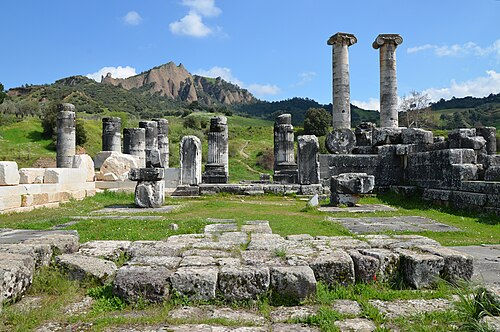
The Place
Sardis was a great city in Asia Minor, the capital of the Lydian kingdom. The King of Lydia, Croesus, was so wealthy that being "as rich as Croesus" became a saying. It was located on a major commercial trade route running east from the Adriatic Coast to Syria. It was at the foot of Mount Timolus, on the river Pactolus and close to the river Hermes. It was wealthy from making and dying wool and textiles, as well as the gold found in the Pactous River. Archaeologists have found hundreds of crucibles for refining gold [1]. Sardis is the first place in the world to have minted coins [2]. Largely destroyed by the earthquake of AD 17, Emperor Tiberius allowed tax breaks to help rebuild the city. Under the Roman Empire, it was the main judicial city of Phrygia.
Religion in Sardis
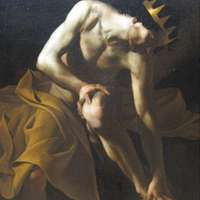
Sardis had a magnificent Temple of Artemis as well as a large Jewish synagogue [3] and a temple to the goddess Cybele [4].
Sardis is the home of the myth of Midas and the golden touch. In ancient Greek and Roman legend, the king of Phrygia, Midas, wished that all he touched might turn to gold. When his food became gold and he nearly starved to death, he realized his error. Dionysus then granted him release by having him bathe in the Pactolus River near Sardis. The legend explains the vast findings of gold in that riverbed [5]
Sardis in Revelation
In the vision described in Revelation, Christ contrasts Sardis being alive or dead, being asleep or awake, wearing stained robes or white robes.
“And to the angel of the church in Sardis write: These are the words of him who has the seven spirits of God and the seven stars:
“I know your works; you have a name of being alive, but you are dead. Wake up and strengthen what remains and is on the point of death, for I have not found your works perfect in the sight of my God. Remember, then, what you received and heard; obey it and repent. If you do not wake up, I will come like a thief, and you will not know at what hour I will come to you. Yet you have still a few persons in Sardis who have not soiled their clothes; they will walk with me, dressed in white, for they are worthy. If you conquer, you will be clothed like them in white robes, and I will not erase your name from the book of life; I will confess your name before my Father and before his angels. Let anyone who has an ear listen to what the Spirit is saying to the churches (Revelation 3:1-6 NRSVUE).
The People
The specific individual who first brought Christianity to Sardis is not revealed in the Bible or in church history or in traditions. Traditional theologians credit it to Paul, who was in Ephesus, 150 km away. The Bible does not say Paul went to Sardis, and the Bible does name several other Christian teachers who used Ephesus as their home base (Apollo, Priscilla, Aquilla). Others credit John for bringing Christianity to Sardis because traditionally, Apostle John and Jesus's mother Mary lived for a time in Ephesus, and John mentions Sardis in the book of Revelation. There were many Christian evangelists whose travels are unknown, including the Apostle Junia. Junia and Andronicus are known for later doing extensive missions east of the Adriatic Sea (Illyricum, Pannonia, and Dalmatia). It seems plausible that as an outstanding apostle, Junia could have done more than one mission journey.
What Might Junia Do?
She may have tried to wake up these lovers of gold to their need for spiritual wealth.
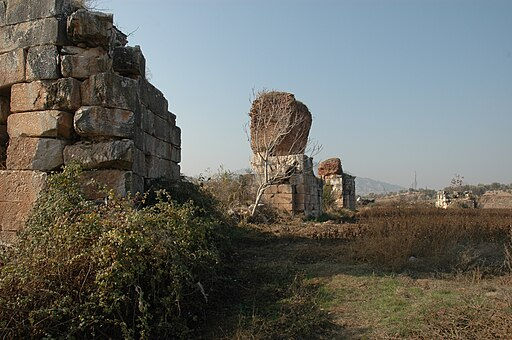
Smyrna
The Place
Ancient coins from Smyrna were engraved with "First of Asia in size and beauty" and "The Ornament of Asia." It was not only a centre of wealth and prosperity but also learning and religion, festivals and athletic contests [1]. It had tremendous city walls, gates, library, schools of science and medicine, town squares, a gymnasium, stadium, and a theatre large enough to hold 20,000 people.

Ancient Smyrna was described with a "crown of porticoes," which may refer to the circle of grand public buildings around the summit of Mount Pagos. Ancient references to the "crown of Smyrna" may also relate to the city's goddess, Cybele, shown on Smyrna's coinage wearing a crown that looked like turrets of the city walls. Smyrna was the birthplace of Homer, author of the Iliad and the Odyssey. Smyrna had a wonderful, naturally protected harbour at the mouth of the Hermus River, making it an excellent centre for trade from the Adriatic Sea east through Asia Minor to Syria. Smyrna was renowned for its figs and woollen cloth. Smyrna remains an important commercial city, today called Izmir [2].
Religion in Smyrna
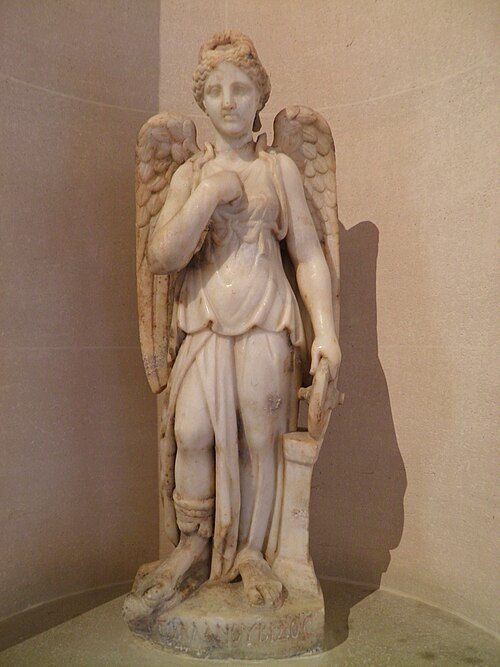
Smyrna had a Jewish synagogue as well as temples to Zeus (king of gods), Cybele (great mother of gods), Aphrodite (goddess of love), and Dionysius (god of wine and fertility). It also had many imperial cult worshippers and built a temple and statue to honour Emperor Tiberius [3]. There was also a large cult of Nemesis at Smyrna.
Nemesis is a Greek goddess of retribution and vengeance. Nemesis often holds a wheel to symbolize her control over the turning wheel of fortune or fate. The wheel represents the cyclical nature of life, where fortunes can shift and change. Nemesis enforces justice, balancing the excesses of good or bad, bringing low the arrogant and uplifting the impoverished [4].
Smyrna in Revelation Only Philadelphia and Smyrna receive praise and not condemnation in Revelation. Smyrna is commended for coming to life, for being spiritually rich while materially persecuted. The vision shows Christ awarding them a crown of life after they endure and overcome their troubles.
“And to the angel of the church in Smyrna write: These are the words of the First and the Last, who was dead and came to life: “I know your affliction and your poverty, even though you are rich. I know the slander on the part of those who say that they are Jews and are not but are a synagogue of Satan. Do not fear what you are about to suffer. Beware, the devil is about to throw some of you into prison so that you may be tested, and for ten days you will have affliction. Be faithful until death, and I will give you the crown of life. Let anyone who has an ear listen to what the Spirit is saying to the churches. Whoever conquers will not be harmed by the second death. (Revelation 2:8-11, NRSVUE)
The People
The Bible does not record the first person to bring the news of Christ to Smyrna.
The earliest records of the church note that Polycarp of Smyrna was a disciple of Apostle John was a Christian leader in the early second century. Church historians Tertullian, Eusebius, and Jerome confirm that Polycarp became the bishop of Smyrna and was martyred around AD 155 [5].

The first person to bring the news of Jesus to Smyrna is not named in the Bible or in ancient church traditions or records. It could have been an apostle like Junia.
What might Junia do?
She could relate to the local ideas of balancing justice and mercy. She could relate to the fig farmers by telling them about Jesus cursing a fig tree because its leaves made it appear to have fruit, but it was barren. In the same way, those who say they are God's people but are not will be revealed by their lack of good fruit. It is a comfort to believe that God will balance out the excesses of fortune for the false religious leaders and those who are oppressed by them.
Sources:
Conclusion
Junia founded churches and commissioned women house church leaders.
Over a period of weeks, Junia told the congregation all about the people she had met, the fears and questions they had, and how God had worked miracles through her and saved her from a dark prison. She told them about the stories, songs, and scriptures that she had left with the new leaders who would host the home churches she had planted. Apphia had absorbed her teachings about equality and became a patron, establishing a church in her home in Colossae. Nympha had rescued her from prison and now taught God’s word in her home in Laodicea. Junia told them about Mariamne and all that had happened in Hierapolis. Ammia was a prophet and patron of a new congregation in Philadelphia. She told them how spreading the seed of God’s word turned enemies into friends. She shared the confidence and peace that she felt about Smyrna and the other cities remaining faithful. - Chapter 39, Finding Her Voice
Elaine Ricker Kelly Author is empowering women with historical fiction about women in the Bible and early church and Christian blogs about women in leadership, church history and doctrine. Her books include:
Forgotten Followers from Broken to Bold, Book 1, A Novel (2022)
The Sword: A Fun Way to Engage in Healthy Debate on What the Bible Says About a Woman's Role (2023)
Because She Was Called from Broken to Bold, Book 2, A Novel of the Early Church (2024)
Walk with Mara on Her Healing Journey: 21 Steps to Emotional Resilience (2024)
Finding Her Voice from Broken to Bold, Book 3, Acts of Early Female Apostles: A Novel




Comments